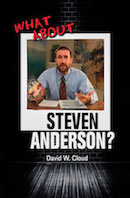866-295-4143, fbns@wayoflife.org
Lying art.
HAECKEL’S EMBRYO CHART
It was Ernest Haeckel, Charles Darwin’s most enthusiastic disciple in Germany, who devised the iconic embryo chart “proving” that at the embryonic stage man looks almost exactly like various types of animals.
He based this on his “law of recapitulation” (also called the biogenetic law) which stated that the human embryo goes through an evolutionary cycle during which it resembles a single-celled marine organism, then a worm, then a fish with gill slits, then a monkey with a tail, and finally a human. According to recapitulation, each creature repeats or recapitulates the entire alleged evolutionary history. Thus, the human embryo progresses from a single cell to a fish to an amphibian to a reptile to a mammal to an ape to a human.
Haeckel’s embryo chart first appeared in print in 1866 in his book Generalle Morphologie der Organismen and in 1868 in The Natural History of Creation, and since then it has been republished in various forms in countless textbooks, journals, popular reports, and museums. It is still appearing in textbooks in the 21st century. One teacher said, “I have taught Jr. High Science for over 35 years. Every textbook from every major publisher I have ever seen has had Haeckel’s embryos pictured and the text usually claims this as a proof for evolution” (http://creation.com/fraud-rediscovered).
The influence of the embryo chart has been incalculable. Dr. Carl Werner testifies that he was confronted with Haeckel’s embryo chart in his first class in medical school in 1977, and this convinced him that evolution is true.
“These drawings were extremely compelling to me, especially the ‘fact’ that humans had gills and a tail. After this lecture, I found myself rapidly accepting evolution” (Evolution: The Grand Experiment, Vol. 2, p. 2).
The problem is that it is a grand scientific fraud, and it has been known by scientists to be a fraud since the 19th century!
Haeckel mislabeled embryos; he changed the size of embryos; he deleted parts; he added parts; he changed parts. For example, Haeckel took a drawing of a monkey embryo and removed its arms, legs, navel, heart, and yolksac to make it look like a fish embryo. He then labeled it “Embryo of a Gibbon in the fish-stage.” In fact, it wasn’t a gibbon even before it was doctored; it was some other type of ape.
For his “embryo of man in the fish-stage,” Haeckel either removed or doctored more than half of the embryos’ essential organs.
“His piece de resistance was his manipulation of the drawing of a human embryo by Ecker. He changed the details of the human eye significantly, made the human posterior twice its actual length, took 2 mm off the head, and like the Macaque, removed the arms, legs and heart” (“The Life of Ernst Haeckel,” Creation Worldview Ministries, http://www.creationworldview.org/articles_view.asp?id=29).
Haeckel also brazenly ignored every facet of embryology that directly disproved his theory.
Haeckel’s deception was exposed by Ludwig Rutimeyer, a professor at the University of Basel, who brought the matter to the attention of the university at Jena. Rutimeyer called the drawings “a sin against scientific truthfulness.” Rutimeyer demonstrated that Haeckel had used the same woodcut of a dog embryo three times to depict the supposed wormlike stage of what he called the embryos of a dog, a chicken, and a tortoise. Haeckel was convicted at a university tribunal and made a “confession” of sorts, but even his confession was a lie. He claimed that his draughtsman made the blunder, not acknowledging that he was the draughtsman (Russell Grigg, “Fraud Rediscovered,” http://creation.com/fraud-rediscovered).
Haeckel’s embryo fraud was also exposed early on by Wilhelm His, Sr., professor of anatomy at the university of Leipzig. His showed how that Haeckel had doctored his embryo charts to make them fit his theory and concluded that “anyone who engaged in such blatant fraud had forfeited all respect and that Haeckel had eliminated himself from the ranks of scientific research workers of any stature” (cited from Shawn Boonstra, Out of Thin Air, p. 47).
In spite of his deception and in spite of having been exposed, Haeckel continued as a professor at Jena for another 30 years and continued to promote his evolutionary deception far and wide.
In 1915 Haeckel’s fraud was publicized in the book Haeckel’s Frauds and Forgeries by Joseph Assmuth and Ernest Hull, which cited 19 authorities, but this carefully documented work was largely ignored by Darwinian scientists and educators in their zeal to disprove the Bible.
In the late 1990s, a team led by Michael Richardson, embryologist at St. George’s Hospital Medical School, London, did extensive research into the embryo to test Haeckel’s chart. Richardson gathered an international team of scientists who examined and photographed embryos of 39 different species at stages comparable to those depicted in Haeckel’s chart. Richardson concluded that Haeckel was “an embryonic liar.” In a 1997 interview with Nigel Hawkes, Richardson said,
‘THIS IS ONE OF THE WORST CASES OF SCIENTIFIC FRAUD. It’s shocking to find that somebody one thought was a great scientist was deliberately misleading. It makes me angry … What he [Haeckel] did was to take a human embryo and copy it, pretending that the salamander and the pig and all the others looked the same at the same stage of development. They don’t … These are fakes” (Nigel Hawkes’ interview with Richardson, The Times, Aug. 11, 1997, p. 14).
A major error of Haeckel’s embryo chart is the misidentification of “gill slits” on the human embryo. In fact, they are not gill slits at all. They have no respiratory function. “The so-called ‘gill slits’ are really wrinkles in the throat region. This body tissue becomes the palatine tonsils, middle ear canal, parathyroid gland, and thymus. ... These folds in the neck region of the mammalian embryo are not gills in any sense of the word and never have anything to do with breathing. They are merely inward folds, or wrinkles, in the neck region resulting from the sharply down-turned head and protruding heart of the developing embryo” (Alan Gillen, Body by Design, p. 33)
Child psychologist Benjamin Spock promoted Haeckel’s doctrine of recapitulation in his popular books:
“Each child as he develops is retracing the whole history of mankind, physically and spiritually, step by step. A baby starts off in the womb as a single tiny cell, just the way the first living thing appeared in the ocean. Weeks later, as he lies in the amniotic fluid of the womb, he has gills like a fish...” (Baby and Child Care, 1957, p. 223).
Haeckel’s myth that the developing human embryo is animal-like has encouraged the modern abortion industry. Dr. Henry Morris wrote:
“We can justifiably charge this evolutionary nonsense of recapitulation with responsibility for the slaughter of helpless, pre-natal children--or at least for giving it a pseudo-scientific rationale” (The Long War against God, 1989, p. 139).
We have seen that Haeckel believed that the embryo is still in the evolutionary stage and not fully human. He said that it is “completely devoid of consciousness, is a pure ‘reflex machine,’ just like a lower vertebrate” (Weikart, p. 147). Thus, killing an unborn baby would be like killing an animal.
Haeckel taught that even the newborn child has no soul and therefore infanticide “cannot rationally be classed as murder” (Haeckel, The Wonders of Life, 1904, p. 21). For physically or mentally handicapped infants, Haeckel recommended “a small dose of morphine or cyanide” (Weikart, p. 147).
In 1990, Carl Sagan and his wife, Ann Druyan, argued that abortion is ethical on the grounds that the fetus is not fully human until the sixth month. Taking Haeckel’s recapitulation theory as fact, they claimed that the embryo begins as “a kind of parasite” and changes into something like a fish with “gill arches” and then becomes “reptilian” and finally “mammalian.” By the end of the second month, the fetus “is still not quite human” (“The Question of Abortion: A Search for the Answers,” Parade, April 22, 1990).
Biology textbooks continue to use the embryo chart as a major evidence for evolution. In some cases, they repeat Haeckel’s doctrine of recapitulation, while it is more common for the embryo chart to be used as an example of homology.
Biology: The Dynamics of Life by Merrill Publishing (1991) goes full bore for the doctrine of recapitulation:
“The fossil record indicates that aquatic, gill-breathing vertebrates preceded air-breathing land forms, and comparisons of embryos of different classes of vertebrates support this view of evolutionary change. An embryo is an organism in its earliest stages of development. In the early stages of embryo development of reptiles, birds, and mammals, a tail and gill slits can be observed. As you know, fish use gills to breathe under water. Fish embryos retain these structures; reptile, bird, and mammal embryos lose them as their development continues. In the human embryo, a tail is visible up to the sixth week of development. In humans, the tail disappears, but in fish, reptiles, and birds the tail is retained into maturity” (Biology: The Dynamics of Life, p. 202).
Modern Biology by Holt, Rinehart, and Winston (1999) features the chart on page 291 with the accompanying text: “Although modern embryologists have discovered that Haeckel exaggerated some features in his drawings, it is true that early embryos of many different vertebrate species look remarkably similar.”
(Observe how casually this textbook whitewashes Haeckel’s deception!)
The Prentice Hall Biology textbook of 2002, edited by Kenneth Miller and Joseph Levine, is another example of the use of the embryo chart as homology. On page 385 there are photos of the embryos of a chicken, turtle, and rat, with this statement: “In their early stages of development, chickens, turtles, and rats look similar, providing evidence that they shared a common ancestry.”
While some evolutionists are using modified editions of Haeckel’s embryonic chart, others have removed his name and attributed the chart to Karl Ernst von Baer, the discoverer of the female egg cell. This is a great error, because von Baer taught against Darwinian evolution as well as against Haeckel’s doctrine of recapitulation!
This error of attributing embryonic recapitulation to von Baer actually started with Charles Darwin, who quoted him in On the Origin of Species.
“Darwin cited von Baer as the source of his embryological evidence, but at the crucial point Darwin distorted that evidence to make it fit his theory. Von Baer lived long enough to object to Darwin’s misuse of his observations, and he was a strong critic of Darwinian evolution until his death in 1876” (Jonathan Wells, Icons of Evolution, p. 86).
In a 2008 documentary, Oxford atheist Richard Dawkins was still using the Haeckel embryo chart. Entitled “The Genius of Charles Darwin,” the documentary was a three-part television production written and presented by Dawkins. It was first shown in August 2008 on British channel 4. The Haeckel chart appears in episode 1.
Science is self-correcting, we are told. But deceptive evolutionary icons such as the embryo chart, the horse chart, and the peppered moth have continued to be used decade after decade even though they have been debunked. In fact, the embryo chart was debunked more than a century age.
Great spiritual and moral damage can be done by the perpetuation of myths.
- Receive these reports by email
- www.wayoflife.org
______________________
Sharing Policy: Much of our material is available for free, such as the hundreds of articles at the Way of Life web site. Other items we sell to help fund our expensive literature and foreign church planting ministries. Way of Life's content falls into two categories: sharable and non-sharable. Things that we encourage you to share include the audio sermons, O Timothy magazine, FBIS articles, and the free eVideos and free eBooks. You are welcome to make copies of these at your own expense and share them with friends and family. You may also post parts of reports and/or entire reports to websites, blogs, etc as long as you give proper credit (citation). A link to the original report is very much appreciated as the reports are frequently updated and/or expanded. Things we do not want copied and distributed are "Store" items like the Fundamental Baptist Digital Library, print editions of our books, electronic editions of the books that we sell, the videos that we sell, etc. The items have taken years to produce at enormous expense in time and money, and we use the income from sales to help fund the ministry. We trust that your Christian honesty will preserve the integrity of this policy. "For the scripture saith, Thou shalt not muzzle the ox that treadeth out the corn. And, The labourer is worthy of his reward" (1 Timothy 5:18). Questions? support@wayoflife.org
Goal:Distributed by Way of Life Literature Inc., the Fundamental Baptist Information Service is an e-mail posting for Bible-believing Christians. Established in 1974, Way of Life Literature is a fundamental Baptist preaching and publishing ministry based in Bethel Baptist Church, London, Ontario, of which Wilbert Unger is the founding Pastor. Brother Cloud lives in South Asia where he has been a church planting missionary since 1979. Our primary goal with the FBIS is to provide material to assist preachers in the edification and protection of the churches.
Offering: Offerings are welcome if you care to make one. If you have been helped and/or blessed by our material offerings can be mailed or made online with with Visa, Mastercard, Discover, or Paypal. For information see: www.wayoflife.org/about/makeanoffering.html.





